Searching around for artwork by Frieda Harris turned up a few examples I hadn’t seen before including the marvellous painting above which is unfortunately untitled and undated. Harris is very familiar to Aleister Crowley aficionados and those with an interest in the Tarot via her paintings for the Thoth Tarot deck, a project that she and Crowley worked on during the 1930s. The deck is justly celebrated for its modernising of the Tarot symbolism, and for its radical art style which wasn’t afraid to combine some of the developments in 20th-century art with Harris’s studies of Projective Synthetic Geometry.
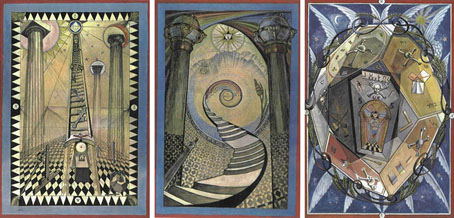
Masonic Tracing Boards.
Less familiar is her work away from the Tarot deck, some of which can be seen here. Prior to meeting Crowley, Harris was involved with Freemasonry for which she produced three designs for the Masonic teaching aids known as Tracing Boards. (See larger copies here.) I used to think these looked like outtakes from the Tarot deck but seeing them in the light of the mysterious painting above it’s evident that the Tarot style wasn’t unique to that set of cards.
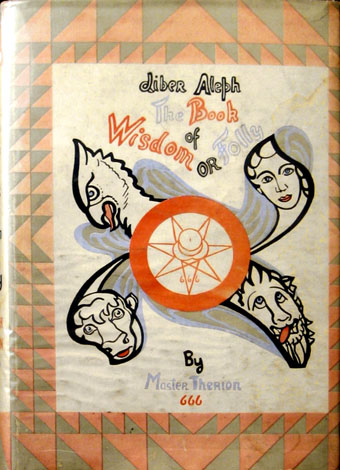
Liber Aleph vel CXI: The Book of Wisdom or Folly (1918) by Aleister Crowley.
A book cover which pre-dates the Tarot designs. The heads are the traditional embodiments of the four elements but with one change: the human figure has a feminine face rather than the usual masculine features. The same figures appear on her painting for the final Tarot Trump, The Universe (below), but in a more traditional guise.
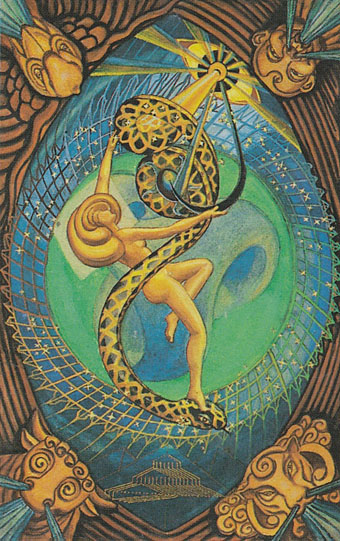
The Universe (Crowley’s updating of The World).
Snakes And Ladders (2003) by Alan Moore & Tim Perkins.
Frieda Harris and her Universe card were referenced in the Snakes And Ladders album by Alan Moore & Tim Perkins. The cover of the CD was my own variation on her painting, while the insert included a couple more pieces of her work including the Masonic designs.
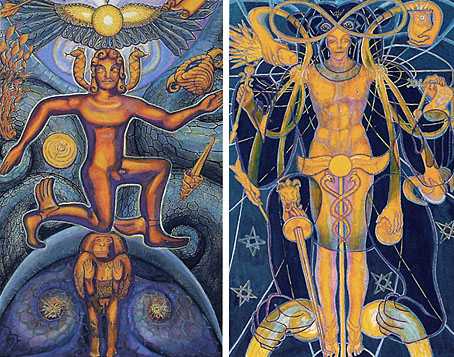
Two unused versions of The Magus.
And it’s variations that we end with. Some of the cards in the Thoth deck underwent many revisions until Crowley felt that all the relevant symbolism had been adequately accounted for. Four different versions of The Magus (Crowley’s Magician) can be seen here, and I’ve seen at least one other version; with the final draft that makes six in total. The face on the version of The Fool below was based on Harpo Marx, a surprising nod to popular culture which was dropped from the final designs.
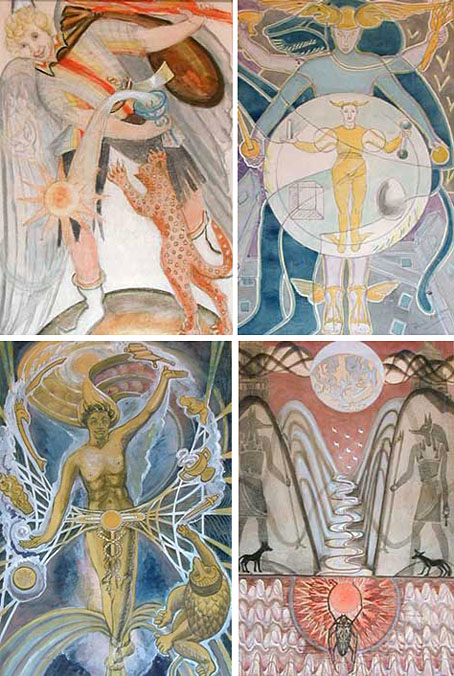
More unused designs. Top left: The Fool; top right: The Magus; bottom left: The Magus; bottom right: The Moon.
There’s more about the creation of the Thoth deck, and the long friendship between Harris and Crowley, here and here, a relationship which remained untroubled by Crowley’s habit of alienating friends and allies. The pair of them can be seen together in a photo here.
Previously on { feuilleton }
• The art of Fay Pomerance, 1912–2001
• The art of Pamela Colman Smith, 1878–1951
• The art of Cameron, 1922–1995

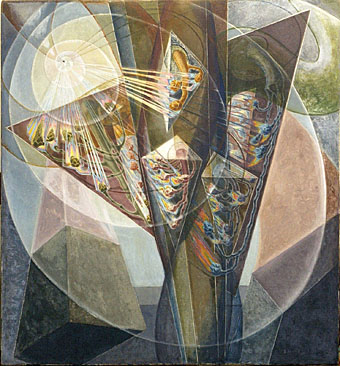

The human figure on that book cover should be a hermaphrodite, but since Harris used a male penis in the center of the pentacle, that probably should cover it. Or, at least, I think som since the image predates the one she uded on the card XXI, the Universe.
The figure could well be intended as androgynous which is why I described it as feminine rather than saying it was a woman. The face on the Tarot card, by contrast, looks deliberately male.
The pentacle on the book cover is Crowley’s own Mark of the Beast. The central device looks simultaneously phallic whilst also representing the Sun in the arms of the Moon.
Indeed, thanks for the tips, they’re useful, since I read the Tareot using Crowley/Harris’s cards, most of the time, also the Rider-Waite one. Bye!